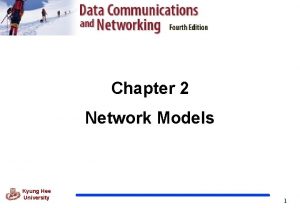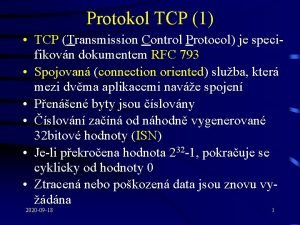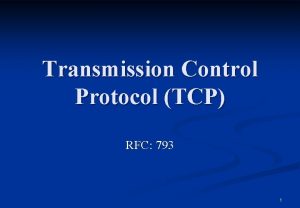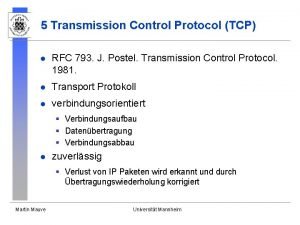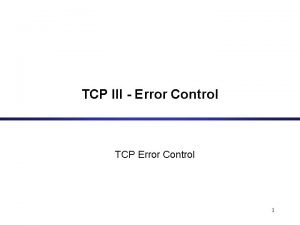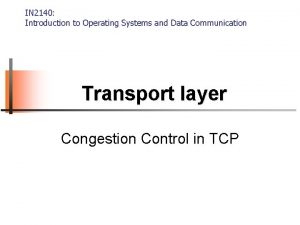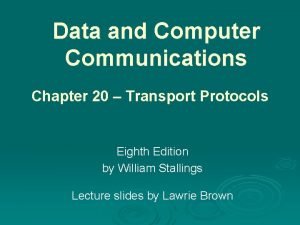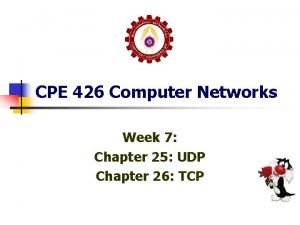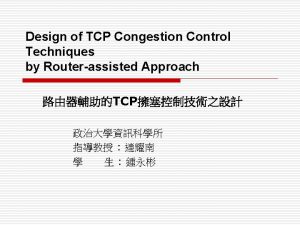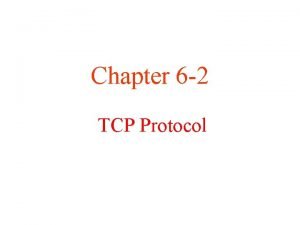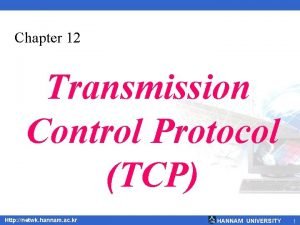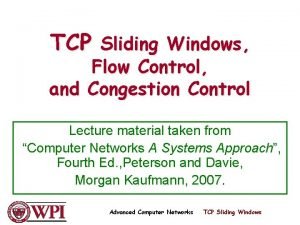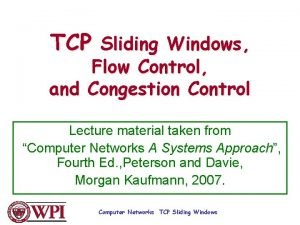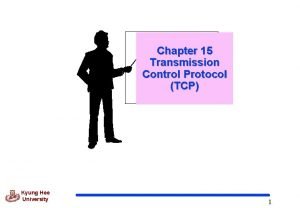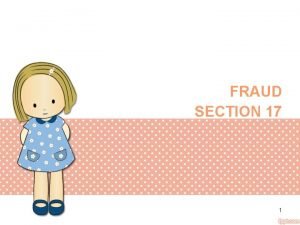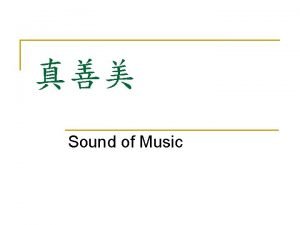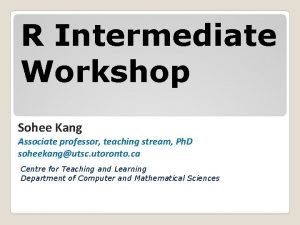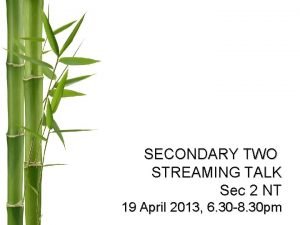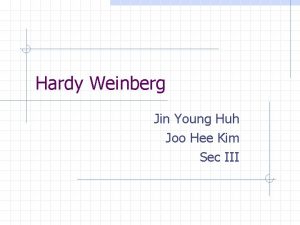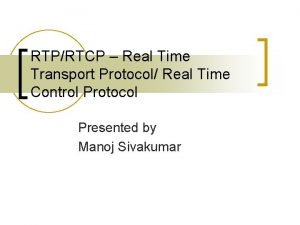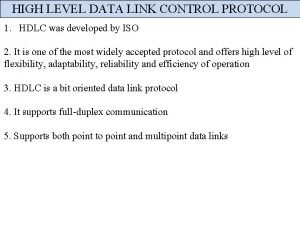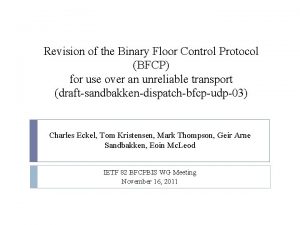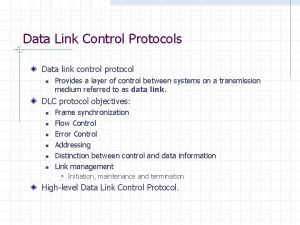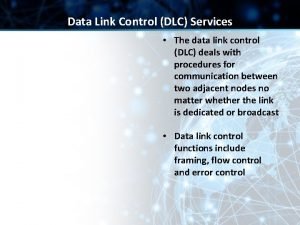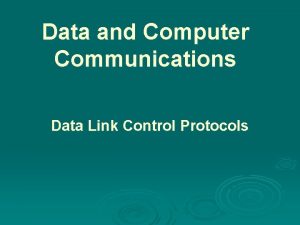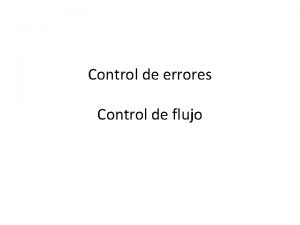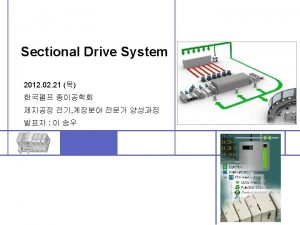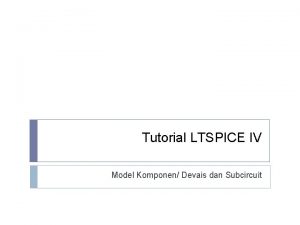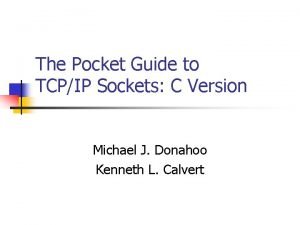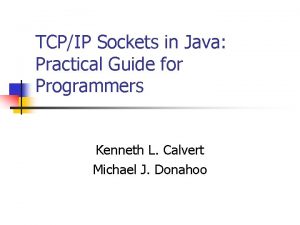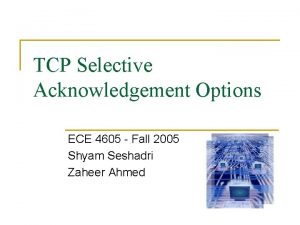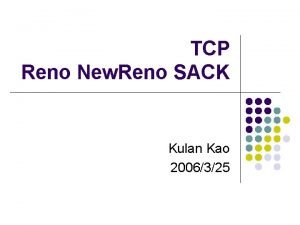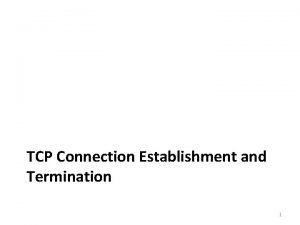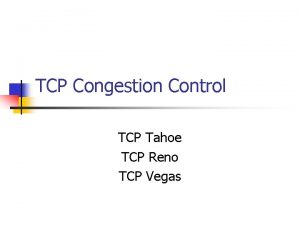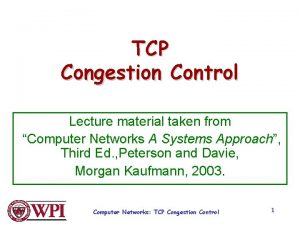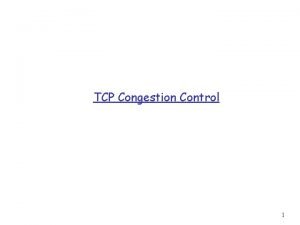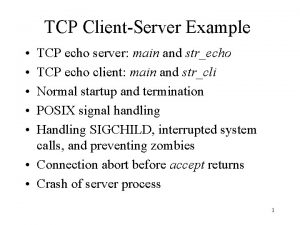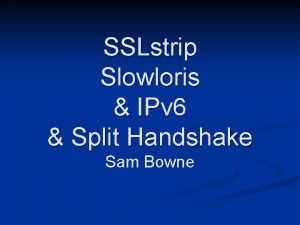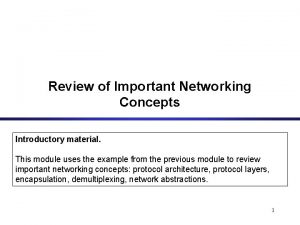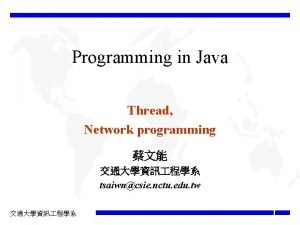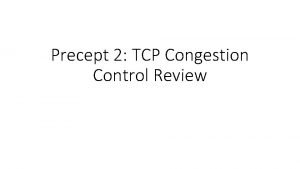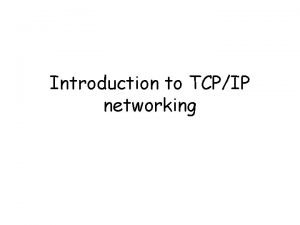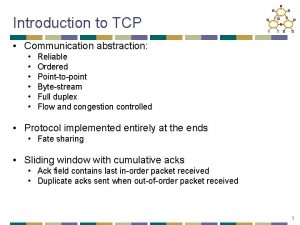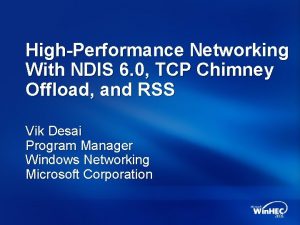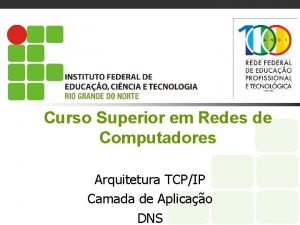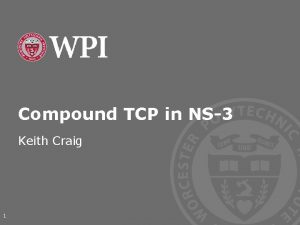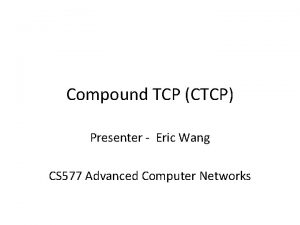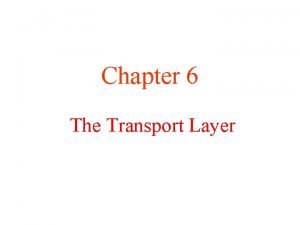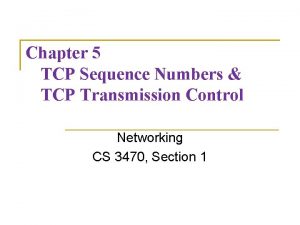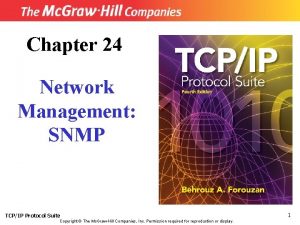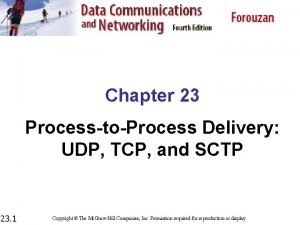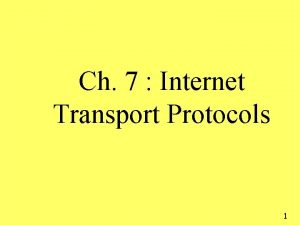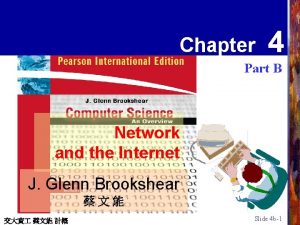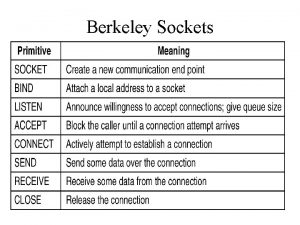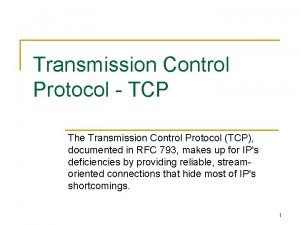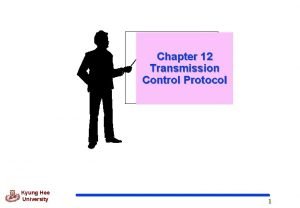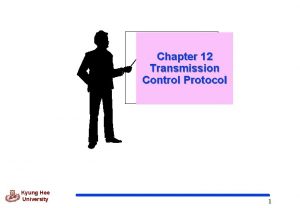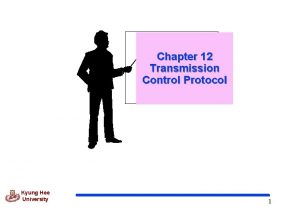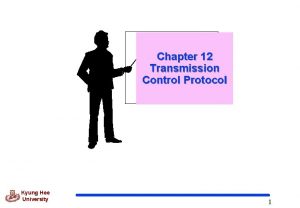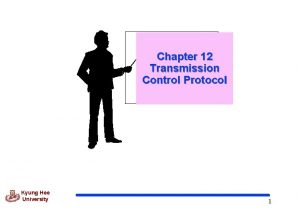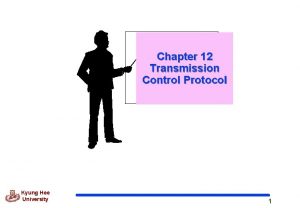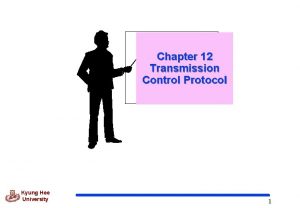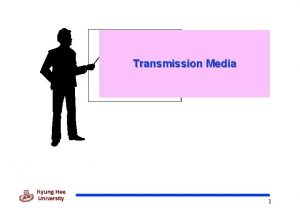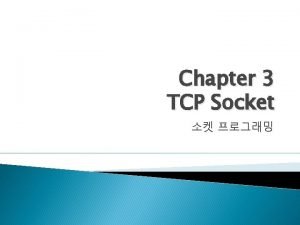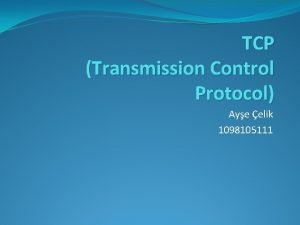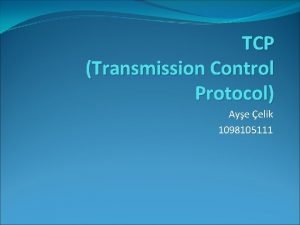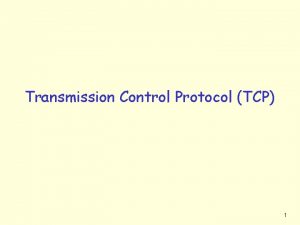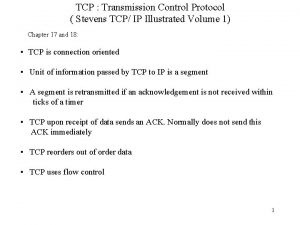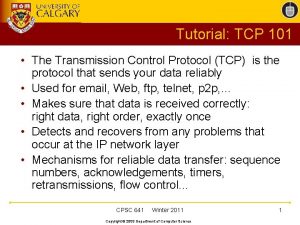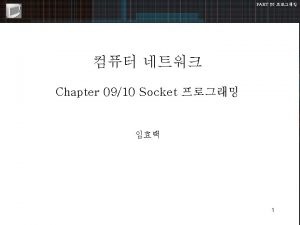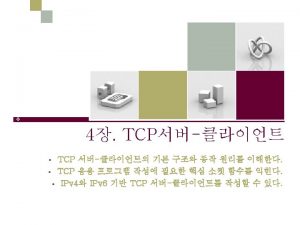Chapter 15 Transmission Control Protocol TCP Kyung Hee














































































































- Slides: 110

Chapter 15 Transmission Control Protocol (TCP) Kyung Hee University 1

15. 1 TCP Services q TCP/IP protocol suite Kyung Hee University 2

Well-known ports used by TCP Kyung Hee University 3

Stream Delivery q. Stream Data Service (stream transport layer service) The sending TCP 1) accepts a stream of characters from sending application program 2) creates packets called segments, of appropriate size extracted from the stream 3) sends segments across the network The receiving TCP 1) receives segments, extracts data from segments 2) orders segments if they have arrived out of order 3) delivers segments as a stream of characters to the receiving application program Kyung Hee University 4

Stream Delivery (cont’d) Kyung Hee University 5

Sending and receiving buffers q For stream delivery, the sending and receiving TCPs use buffers l the sending TCP uses sending buffer to store the data coming from the sending application program. – l the receiving TCP receives the segments and stores them in a receiving buffer – – Kyung Hee University the sending application program writes data to the buffer of the sending TCP the receiving application program uses the read operation to read the data from the receiving buffer. Since the rate of reading can be slower than the rate of receiving, the data is kept in the buffer until the receiving application reads it completely. 6

Sending and receiving buffers (cont’d) Kyung Hee University 7

Segments q. The IP layer, as a service provider for TCP, needs to send data in packets, not as a stream of bytes q. At the transport layer, TCP groups a number of bytes together into a packet called a segment. TCP adds a header to each segment and delivers the segment to the IP layer for transmission Kyung Hee University 8

TCP Segments Kyung Hee University 9

15. 2 TCP Features q. Numbering System q. Flow Control q. Error Control q. Congestion Control Kyung Hee University 10

Numbering System q. Byte numbers All data bytes being transferred in each connection are numbered by TCP. The numbering starts with a randomly generated number. Number range for first byte : 0 ~ 2 32 -1 l If random number is 1, 057 and total number 6, 000 bytes, the bytes are numbered from 1, 057 to 7, 056 Byte numbering is used for flow and error control. Kyung Hee University 11

Numbering System (cont’d) q Sequence number After the bytes have been numbered, TCP assigns a sequence number to each segment that is being sent. Segment number for each segment is number of the first byte carried in that segment. Kyung Hee University 12

Example 15. 1 Suppose a TCP connection is transferring a file of 5, 000 bytes. The first byte is numbered 10, 001. What are the sequence numbers for each segment if data are sent in five segments, each carrying 1, 000 bytes? Solution The following shows the sequence number for each segment: Kyung Hee University 13

Numbering System (cont’d) q. Acknowledgment Number The value of the acknowledgment field in a segment defines the number of the next byte a party expects to receives. The acknowledgment number is cumulative. Kyung Hee University 14

15. 3 Segment q. TCP Segment Format Kyung Hee University 15

Segment (cont’d) q. Source port address defining the port number of application program in the host that is sending the segment q Destination port address defining the port number of application program in the host that is receiving the segment q Sequence number defining the number assigned to the first byte of data contained in this segment during the connection establishment, each party uses a random number generator to create an initial sequence number (ISN) Kyung Hee University 16

Segment (cont’d) q. Acknowledgment number If the source of the segment has successfully received byte number x from the other party, it defines x+1 as the acknowledgment number q Header length Indicating the number of 4 -byte words in the TCP header l the value between 5 and 15 (20 and 60 bytes) q Reserved For future use Kyung Hee University 17

Segment (cont’d) q. Control Enabling flow control, connection establishment and termination, and mode of data transfer in TCP Kyung Hee University 18

Segment (cont’d) q. Window size defining the size of the window, in bytes, that the other party must maintain. maximum size of window : 65, 535 bytes q Checksum : picture in next page q Urgent pointer used when the segment contains urgent data defining the number that must be added to the sequence number to obtain the number of the last urgent byte in the data section of the segment q Options : 40 bytes Kyung Hee University 19

Pseudoheader added to the TCP segment l Kyung Hee University The use of the checksum in TCP is mandatory. 20

Encapsulation q. A TCP segments is encapsulated in an IP datagram Kyung Hee University 21

15. 4 A TCP Connection q. TCP is connection-oriented Establishes a virtual path between the source and destination TCP connection is virtual, not physical q. TCP uses the services of IP to deliver individual segments to the receiver, but it controls the connection itself q If a segment is lost or corrupted, it is retransmitted Kyung Hee University 22

Connection Establishment using Three-way Handshake q. The server program tells its TCP to make a passive open q The Client program issues a request for an active open. Kyung Hee University 23

Connection Establishment using Three-way Handshake (cont’d) q. A SYN segment cannot carry data, but it consumes one sequence number. q. A SYN + ACK segment cannot carry data, but does consume one sequence number. q. An ACK segment, if carrying no data, consumes no sequence number. Kyung Hee University 24

Data Transfer Establishment Termination Kyung Hee University 25

Data Transfer (cont’d) q. Urgent data To send urgent data Use of URG bit set by sending TCP Receiving TCP extracts the urgent data from the segment using urgent pointer Kyung Hee University 26

Connection Termination using Three-way Handshake Kyung Hee University 27

Connection Termination using Three-way Handshake (cont’d) q. The FIN segment consumes one sequence number even if it does not carry data q. The FIN + ACK segment consumes one sequence number even if it does not carry data Kyung Hee University 28

Half-Close Kyung Hee University 29

15. 5 State Transition Diagram q. To keep track of all the different events happening during connection establishment, connection termination, and data transfer, the TCP software is implemented as a finite state machine. Kyung Hee University 30

State Transition Diagram (cont’d) Kyung Hee University 31

State for TCP Kyung Hee University 32

Scenarios q. To understand the TCP state machines and the transition diagrams, we go through some scenario in this section. q. Connection Establishment and half-Close Termination Scenario where the server process issues a passive open and passive close, and the client process issues an active close. Kyung Hee University 33

Transition Diagram for Connection and Half-close Termination Kyung Hee University 34

Time-line diagram for previous Transition Diagrams Kyung Hee University 35

Transition Diagram for a Common Scenario Kyung Hee University 36

Time Line for a Common Scenario Kyung Hee University 37

Simultaneous Open Kyung Hee University 38

Simultaneous Close Kyung Hee University 39

Denying a Connection Kyung Hee University 40

Aborting a Connection Kyung Hee University 41

15. 6 Windows in TCP q. TCP uses two Windows Send window and receive window q. This means four windows for a bidirectional communication To make simple, we make an assumption that communication is only unidirectional The bidirectional communication can be inferred using two unidirectional communications with piggybacking Kyung Hee University 42

Send Window in TCP Kyung Hee University 43

Receive Window in TCP Kyung Hee University 44

15. 7 Flow Control q In TCP, the sender window size is totally controlled by the receiver window value. However, the actual window size can be smaller if there is congestion in the network. q Some Points about TCP’s Sliding Windows: The size of the window is the lesser of rwnd and cwnd The source does not have to send a full window’s worth of data. The window can be opened or closed by the receiver, but should not be shrunk. The destination can send an acknowledgment at any time as long as it does not result in a shrinking window. The receiver can temporarily shut down the window; the sender, however, can always send a segment of one byte after the window is shut down. l Kyung Hee University To prevent deadlock by proving 45

Data Flow and Flow Control Feedbacks in TCP Kyung Hee University 46

An example of flow control Kyung Hee University 47

Example 15. 2 q Following figure shows the reason for the mandate in window shrinking. Part a of the figure shows values of last acknowledgment and rwnd. Part b shows the situation in which the sender has sent bytes 206 to 214. Bytes 206 to 209 are acknowledged and purged. The new advertisement, however, defines the new value of rwnd as 4, in which 210 + 4 < 206 + 12. When the send window shrinks, it creates a problem: byte 214 which has been already sent is outside the window. The relation discussed before forces the receiver to maintain the right-hand wall of the window to be as shown in part a because the receiver does not know which of the bytes 210 to 217 has already been sent. One way to prevent this situation is to let the receiver postpone its feedback until enough buffer locations are available in its window. In other words, the receiver should wait until more bytes are consumed by its process. Kyung Hee University 48

Example 15. 2 (cont’d) Kyung Hee University 49

15. 8 Error Control q. TCP is a reliable transport layer protocol Application program that delivers a stream of data to TCP relies on TCP to deliver the entire stream to the application program on the other end in order, without error, and without any part lost or duplicated. q. Error control in TCP is achieved through the use of three tools Checksum Acknowledgment Time-Out Kyung Hee University 50

Normal Operation Kyung Hee University 51

Lost Segment Kyung Hee University 52

Fast Retransmission Kyung Hee University 53

Lost Acknowledgment Kyung Hee University 54

Lost Acknowledgment Corrected by Resending a Segment q. Lost acknowledgments may create deadlock if they are not properly handled. Kyung Hee University 55

15. 9 Congestion Control q. Congestion in a network may occur if the load on the network is greater than the capacity of the network q Congestion control refers to the mechanism and techniques to control the congestion and keep the load below the capacity q Congestion in a network or internetwork occurs because routers and switches have queues. Kyung Hee University 56

Congestion Control (cont’d) q. Congestion window Today, TCP protocols include that the sender’s window size is not only determined by the receiver but also by congestion in the network Actual window size = minimum (rwnd, cwnd) Kyung Hee University 57

Slow Start, Exponential Increase Kyung Hee University 58

Congestion Control (cont’d) q. In the slow start algorithm, the size of the congestion window increases exponentially until it reaches a threshold. Start cwnd = 1 After 1 RTT cwnd = 1 x 2 = 2 21 After 2 RTT cwnd = 2 x 2 = 4 22 After 3 RTT cwnd = 4 x 2 = 8 23 Kyung Hee University 59

Congestion Avoidance, Additive Increase q When the size of the congestion window reaches the slow start threshold, in the congestion avoidance algorithm, the size of the congestion window increases additively until congestion is detected Kyung Hee University 60

Congestion Avoidance, Additive Increase Kyung Hee University 61

Congestion Detection : Multiplicative Decrease q. Most implementations react differently to congestion detection: If detection is by time-out, a new slow start phase starts. If detection is by three ACKs, a new congestion avoidance phase starts. Kyung Hee University 62

TCP Congestion Policy Summary Kyung Hee University 63

Congestion Example Kyung Hee University 64

TCP Timers q. To perform its operation smoothly, most TCP implementations uses at least four timers Kyung Hee University 65

TCP Timers (cont’d) q Round Trip Time(RTT) To calculate the retransmission(RTO), we first need to calculate the round-trip time(RTT) In TCP, there can be only one RTT measurement in progress at any time Measured RTT (RTTM) : how long it takes to send a segment and receive an acknowledgment of it. Kyung Hee University 66

TCP Timers (cont’d) q. Smoothed RTT (RTTS) : Weighted average of RTTM and previous RTTS Original No Value After first measurement RTTS = RTTM After any other measurement RTTS = (1 - ) RTTS + · RTTM The value of is implementation-dependent, but it is normally set to 1/8 Kyung Hee University 67

TCP Timers (cont’d) q. RTT Deviation (RTTD) Original No Value After first measurement RTTD = RTTM/2 After any other measurement RTTD = (1 - ) RTTD + · l RTTS – RTTM I * The value of is also implementation dependent, but is it is usually is sent to ¼. Kyung Hee University 68

TCP Timers (cont’d) q. Retransmission Timeout (RTO) Original Initial Value After any measurement RTO = RTTS + 4 RTTD Kyung Hee University 69

Example 15. 3 (cont’d) Let us give a hypothetical example. Figure 15. 39 shows part of a connection. The figure shows the connection establishment and part of the data transfer phases. 1. When the SYN segment is sent, there is no value for RTT M, RTTS, or RTTD. The value of RTO is set to 6. 00 seconds. The following shows the value of these variable at this moment: 2. When the SYN+ACK segment arrives, RTTM is measured and is equal to 1. 5 seconds. Kyung Hee University 70

Example 15. 3 (cont’d) 3. When the first data segment is sent, a new RTT measurement starts. No RTT measurement starts for the second data segment because a measurement is already in progress. The arrival of the last ACK segment is used to calculate the next value of RTTM. Although the last ACK segment acknowledges both data segments (cumulative), its arrival finalizes the value of RTTM for the first segment. The values of these variables are now as shown below. Kyung Hee University 71

Example 15. 3 (cont’d) Kyung Hee University 72

TCP Timers (cont’d) q Persistence Timer When acknowledgment with non-zero window size after zero window size is lost, to correct deadlock, TCP uses a persistence timer for each connection When the sending TCP receives an acknowledgment with a window size of zero, the persistence timer is started When persistence timer goes off, the sending TCP sends a special segment called a probe The probe alerts the receiving TCP that the acknowledgment was lost and should be resent. If a response is not received, the sender continues sending the probe segments and doubling, and resetting the value of the persistence timer until the value reaches a threshold (usually 60 seconds). After that sender sends one probe segment every 60 s until the window is reopened. Kyung Hee University 73

TCP Timers (cont’d) q. Keepalive. Timer Used to prevent a long idle connection between two TCPs. Each time the server hears from a client, it resets this timer. Time-out is usually 2 hours. After 2 hours, sending 10 probes to client (each 75 secs), then terminates connection. q TIME-WAIT Timer The time-wait timer is used during connection termination. Kyung Hee University 74

15. 11 Options q. The TCP header can have up to 40 bytes of optional information q. We can define two categories of options 1 -byte option l l End of option List No operation Multiple-byte option l l l Kyung Hee University Maximum segment size Window scale factor Timestamp SACK-permitted SACK 75

Options (cont’d) Kyung Hee University 76

End-of-option q. End of option (EOP) After this option, the receiver looks for the payload data EOP option imparts 2 pieces of information to the destination 1) 2) No more options in the header Data from the application program starts at the beginning of the next 32 -bit word EOP can be used only once Kyung Hee University 77

No-operation option q. No Operation Is One-byte option used as a filler NOP can be used more than once Kyung Hee University 78

Maximum segment size (MSS) q. Defining the size of the biggest unit of data that can be received by the destination of the TCP segment In spite of its name, defining the maximum size of the data, not the maximum size of the segment Value of 0 to 65, 535 bytes : default is 536 To be determined during the connection establishment phase by the destination of the segment Used only in the segments that make the connections. Not used in the segments during data transfer Kyung Hee University 79

Window-scale-factor option q. Window Scale Factor defining the size of the sliding window l new window size = window size defined in the header x 2 window scale factor l Determined in phase of the connection setup l The largest value of scale factor allowed by TCP/IP is 14. The value of the window scale factor can be determined only during connection establishment; it does not change during the connection Kyung Hee University 80

Timestamp option q. Timestamp 10 -byte option The end with the active open announces a timestamps in the connection request segment (SYN Segment) If it receives a timestamp in the next segment (SYN + ACK) from the other end, it is allowed to use the timestamp. Kyung Hee University 81

Example 15. 5 Following figure shows an example that calculates the round-trip time for one end. Everything must be flipped if we want to calculate the RTT for the other end. Kyung Hee University 82

Example 15. 5 (cont’d) Kyung Hee University 83

SACK q SACK-permitted and SACK Options SACK-permitted option is used only during connection established with SYN segment and SYN + ACK segment. l l SACK-permitted option is not allowed during the data transfer phase. Used to show that the host can support the SACK option. SACK Option is used during data transfer only if both ends agree l Kyung Hee University The option includes a list for blocks arriving out-of-order. 84

SACK (cont’d) Kyung Hee University 85

Example 15. 6 Let us see how the SACK option is used to list out-oforder blocks. In Figure 15. 49 an end has received five segments of data. Kyung Hee University 86

Example 15. 7 Following figure shows how a duplicate segment can be detected with a combination of ACK and SACK. In this case, we have some out-of-order segments (in one block) and one duplicate segment. To show both out-of-order and duplicate data, SACK uses the first block, in this case, to show the duplicate data and other blocks to show out-of-order data. Note that only the first block can be used for duplicate data. The natural question is how the sender, when it receives these ACK and SACK values, knows that the first block is for duplicate data (compare this example with the previous example). The answer is that the bytes in the first block are already acknowledged in the ACK field; therefore, this block must be a duplicate. Kyung Hee University 87

Example 15. 7 (cont’d) Kyung Hee University 88

Example 15. 8 Figure 15. 51 shows what happens if one of the segments in the out-of-order section is also duplicated. In this example, one of the segments (4001: 5000) is duplicated. The SACK option announces this duplicate data first and then the out-of-order block. This time, however, the duplicated block is not yet acknowledged by ACK, but because it is part of the out-of-order block (4001: 5000 is part of 4001: 6000), it is understood by the sender that it defines the duplicate data. Kyung Hee University 89

Example 15. 8 (cont’d) Kyung Hee University 90

15. 12 TCP Package q. A TCP package involving a table called Transmission Control Blocks, a set of timers, and three software modules: main module, input processing module, output processing module. Kyung Hee University 91

TCP Package (cont’d) Kyung Hee University 92

TCP Package (cont’d) q. Transmission Control Block (TCBs) To control the connection, TCP uses a structure to hold information about each connection. TCP keeps an array of TCBs in the form of a table Kyung Hee University 93

TCP Package (cont’d) State : defining the state of the connection according to the state transition diagram Process : defining the process using this connection at this machine as a client or a server Local IP address : defining the IP address of the local machine used by this connection Local port number : defining the local port number used by this connection Remote IP address Remote port address Interface : defining the local interface Local window : holding information about the window at the local TCP Remote window Kyung Hee University 94

TCP Package (cont’d) Sending sequence number Receiving sequence number Sending ACK number Time-out values : retransmission time-out, persistence time-out, keepalive time-out, and so on Round-trip time Buffer size : defining the size of the buffer at the local TCP Buffer pointer : pointer to buffer where the receiving data is kept until is read by the application Kyung Hee University 95

TCP Main Module q. The main module is invoked by an arrived TCP segment, a time-out, or a message from an application program Kyung Hee University 96

TCP Main Module (Cont’d) Kyung Hee University 97

TCP Main Module (Cont’d) Kyung Hee University 98

TCP Main Module (Cont’d) Kyung Hee University 99

TCP Main Module (Cont’d) Kyung Hee University 100

TCP Main Module (Cont’d) Kyung Hee University 101

TCP Main Module (Cont’d) Kyung Hee University 102

TCP Main Module (Cont’d) Kyung Hee University 103

TCP Main Module (Cont’d) Kyung Hee University 104

TCP Package (cont’d) q. Input processing module handles all the details needed to process data or acknowledgment received when TCP is in the ESTABLISHED state sends an ACK if needed, takes care of the window size, does error checking, and so on q Output processing module handles all the details needed to send out data received from application program when TCP is in the ESTABLISHED state handles retransmission time-outs, persistent time-outs, and so on Kyung Hee University 105

Summary (1/4) q Transmission Control Protocol (TCP) is one of the transport layer protocols in the TCP/IP protocol suite. TCP provides process-to-process, full-duplex, and connection-oriented service. The unit of data transfer between two devices using TCP software is called a segment; it has 20 to 60 bytes of header, followed by data from the application program. q A TCP connection consists of three phases: connection establishment, data transfer, and connection termination. Connection establishment requires three-way handshaking; connection termination requires three- or four-way handshaking. TCP software is normally implemented as a finite state machine. (FSM) Kyung Hee University 106

Summary (2/4) q TCP uses flow control, implement as a sliding window mechanism, to avoid overwhelming a receiver with data. The TCP window size is determined by the receiver-advertised window size (rwnd) or the congestion window size (cwnd), whichever is smaller. The window can be opened or closed by the receiver, but should not be shrunk. The bytes of data being transferred in each connection are numbered by TCP. The numbering starts with a randomly generated number. q TCP uses error control to provide a reliable service. Error control is handled by the checksum, acknowledgement, and time-out. Corrupted and lost segments are retransmitted and duplicate segments are discarded. Data may arrive out of order and temporarily stored by the receiving TCP, but TCP guarantees that no out-of-order segment is delivered to the process. In modern implementations, a retransmission occurs if the retransmission timer expires or three duplicate ACK segments have arrived. Kyung Hee University 107

Summary (3/4) q TCP uses congestion control to avoid and detect congestion in the network. The slow start (exponential increase), congestion avoidance (additive increase), and congestion detection (multiplicative decrease) strategies are used for congestion control. In the slow start algorithm the size of the congestion window increases exponentially until it reaches a threshold. In the congestion avoidance algorithm the size of the congestion window increases additively until congestion is detected. Different TCP implementations react differently to congestion detection: If detection is by time-out, a new slow start phase starts. If detection is by three ACKs, a new congestion avoidance phase starts. q TCP uses four timers (retransmission, persistence, keepalive, and time-waited) in its operation. In TCP, there can be only be one RTT measurement in progress at any time. TCP does not consider the RTT of a retransmitted segment in its calculation of an RTT. Kyung Hee University 108

Summary (4/4) q. TCP uses options to provide more services. The maximum segment size option is used in connection setup to define the largest allowable data segment. The value of MSS is determined during connection establishment and does not change during the connection. The window scale factor is a multiplier that increases the window size. The timestamp option shows how much time it takes for data to travel between sender and receiver. One application of timestamp option is in the calculation of round trip time (RTT). Kyung Hee University 109

Q/A Kyung Hee University 110
 Kyung hee university mba
Kyung hee university mba Kyung hee model
Kyung hee model Kyung hee university hospital at gangdong
Kyung hee university hospital at gangdong Kyung hee university uniform
Kyung hee university uniform Tcp (transmission control protocol) to protokół
Tcp (transmission control protocol) to protokół Transmission control protocol
Transmission control protocol Transmission control protocol
Transmission control protocol Captain kyung
Captain kyung Tcp rfc 793
Tcp rfc 793 Arp protocol in tcp/ip
Arp protocol in tcp/ip L
L Error control in tcp
Error control in tcp Tcp congestion control
Tcp congestion control Tcp congestion control
Tcp congestion control Tcp flow control
Tcp flow control Cpe426
Cpe426 New reno tcp
New reno tcp Tcp
Tcp Tcp flow control
Tcp flow control Tcp flow control diagram
Tcp flow control diagram Error control in tcp
Error control in tcp Tcp flow control sliding window
Tcp flow control sliding window Tcp sliding window
Tcp sliding window Tcp flow control sliding window
Tcp flow control sliding window Transmission control block
Transmission control block Out of programme pause hee
Out of programme pause hee Tan hee juan v the boon keat
Tan hee juan v the boon keat Horus.hee
Horus.hee Horus hee
Horus hee Lau hee teah v hargill engineering sdn bhd
Lau hee teah v hargill engineering sdn bhd Choi dae-hee
Choi dae-hee Yhkim
Yhkim Hee chang trading co. ltd
Hee chang trading co. ltd Tan hee juan case
Tan hee juan case Hee joo lee
Hee joo lee Https://www.youtube.comwatch
Https://www.youtube.comwatch So-hee kang utsc
So-hee kang utsc Aaou
Aaou E horus portfolio
E horus portfolio Secondary 3 streaming
Secondary 3 streaming Joo hee jin
Joo hee jin What is skinny client control protocol
What is skinny client control protocol Real time control protocol
Real time control protocol Domain host control protocol
Domain host control protocol High-level data link control program in c
High-level data link control program in c Bfcp
Bfcp Real time control protocol
Real time control protocol The ppp link control protocol was terminated
The ppp link control protocol was terminated Hdlc osi layer
Hdlc osi layer High level data link control protocol
High level data link control protocol Which protocol has neither flow nor error control
Which protocol has neither flow nor error control Data link control
Data link control Chapter 19 disease transmission and infection prevention
Chapter 19 disease transmission and infection prevention Chapter 19 disease transmission and infection prevention
Chapter 19 disease transmission and infection prevention Chapter 15 infection control
Chapter 15 infection control Chapter 19 disease transmission and infection prevention
Chapter 19 disease transmission and infection prevention Primary control vs secondary control
Primary control vs secondary control Product vs process
Product vs process Fluid mechanics
Fluid mechanics Stock control e flow control
Stock control e flow control Control volume vs control surface
Control volume vs control surface What is a positive control
What is a positive control Negative control definition
Negative control definition Data link control
Data link control Control de errores
Control de errores Negative control vs positive control examples
Negative control vs positive control examples Error control and flow control
Error control and flow control Sectional drive
Sectional drive Komponen pada ltspice
Komponen pada ltspice Server radius packet tracer
Server radius packet tracer Paradox cat hmi
Paradox cat hmi Tcp 101
Tcp 101 Tcp ip sockets in c
Tcp ip sockets in c Tcp/ip sockets in java
Tcp/ip sockets in java Tcp stereo
Tcp stereo Selective acknowledgement
Selective acknowledgement Tcp reno rfc
Tcp reno rfc Purpose of tcp
Purpose of tcp Connection establishment and termination in tcp
Connection establishment and termination in tcp Tcp tahoe
Tcp tahoe Tcp reno fast recovery
Tcp reno fast recovery Tcp reno vs tahoe
Tcp reno vs tahoe Tcp echo server
Tcp echo server Tcp split handshake
Tcp split handshake Tcp header
Tcp header Tcp segment structure
Tcp segment structure A tcp connection is using a window size of 10 000 bytes
A tcp connection is using a window size of 10 000 bytes Modelo osi caracteristicas
Modelo osi caracteristicas Itcp in mobile computing
Itcp in mobile computing Encapsulation tcp/ip
Encapsulation tcp/ip How is tcp an abstraction
How is tcp an abstraction Higher layer ssl protocol
Higher layer ssl protocol Tcp ip
Tcp ip Anycast tcp
Anycast tcp Chimney offload state
Chimney offload state Controllo di flusso e congestione tcp
Controllo di flusso e congestione tcp Arquitetura tcp-ip
Arquitetura tcp-ip Modbus tcp server
Modbus tcp server Arquitetura tcp-ip
Arquitetura tcp-ip Cubic or ctcp
Cubic or ctcp Compound tcp
Compound tcp Tcp ip modle
Tcp ip modle Transport layer primitives
Transport layer primitives Sequence number wrap around
Sequence number wrap around Snmp port number
Snmp port number Tcp and sctp are both layer protocols
Tcp and sctp are both layer protocols Tcp ip modle
Tcp ip modle What is duplicate acknowledgement in tcp
What is duplicate acknowledgement in tcp Osi session layer example
Osi session layer example What is berkeley sockets
What is berkeley sockets Tcp-ip cursus
Tcp-ip cursus

